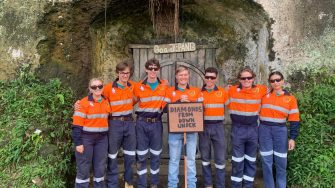UNSW team celebrates success in Indonesian Mining Games
The Mining Engineering students achieved third place in two events of the Indonesian Student Mining Competition, in which they competed as part of an international field trip to Indonesia.
The Mining Engineering students achieved third place in two events of the Indonesian Student Mining Competition, in which they competed as part of an international field trip to Indonesia.

Seven students from the UNSW School of Minerals and Energy Resources Engineering undertook a field trip to Indonesia, where they competed in the Indonesian Student Mining Competition (ISMC) and visited open pit mines.
The ISMC was hosted by The Institute of Technology Bandung (ITB) and featured 15 university teams from Indonesia, Malaysia and Australia. It was the 14th iteration of the event and the first year in which teams from Australia were invited to compete.
Working as a team, students compete in 16 academically and physically challenging tasks, such as track stand, rolling resistance and hand mucking. For each event, points are allocated for safety, teamwork, and correct answers.
“I have previously competed in domestic Mining Games, but the Indonesian games were a whole different ballpark. They focused a lot more on the technical side of mining,” said Liam Brunton, 4th year Petroleum Engineering and Mining Engineering student.
“In terms of preparation, all we had was people’s VAC placements and what they’d learnt in class. Most of our team has just finished their second year, which meant that many of the concepts hadn’t been covered in class yet. It made the competition a challenging and humbling experience,” said Joel Carter, 3rd year Mining Engineering student.
Despite the challenges, the team achieved 3rd place in the Slug Test and Bench Blasting events, surpassing Curtin University and University of Queensland.
The Slug Test event challenges the team regarding their ability in slug test to obtain aquifer hydraulic parameters and mine hydrogeology. In the Bench Blasting event, teams have to determine the blasting geometry, design column charge, and design the ignition pattern to the bench set model of a certain scale.
“The Slug Test was definitely out of our comfort zone. We focused on breaking down the questions and really tried to understand what they were asking of us. Then we allocated specific roles to each team member, which ensured effective teamwork and helped us navigate through the unfamiliar territory,” said Liam.
“For Bench blasting, we had team members with experience in that field, so we left the theoretical component to them. We split up the work evenly and worked as hard as we could. This worked well, and we managed to get a lot more done than other teams,” said Finn Prince, 4th year Mining Engineering student.
“Considering the amount of preparation beforehand, I think we did really well. We went into the competition quite blind, and many of us hadn’t met each other before. I’m really happy with how we worked as a team; it’s something that got commented on by the judges in each event,” said Keisha Sealy, 2nd year Mining Engineering student.
The competition also provided the opportunity to network with other undergraduate mining engineers, expanding the students’ professional network.
“A highlight for me was speaking directly with undergraduate mining students at ITB and recognising just how big that cohort was. There were about 300 students, compared to 60 or 70 at UNSW. It was amazing to see their comprehensive facilities, such as shaking tables, flotation cells, magnetic disc separators,” said Duncan Slater, 4th year Mining Engineering student and Team Captain.
Before competing in the competition, the team toured two open pit coal mines in South Kalimantan, the Asam-Asam mine and Kintap mine, both owned by mining company Arutmin.
From viewing and being explained functions of the crusher, conveyor system, excavators, trucks, workshop, and shipping port, students were exposed first-hand to the entire value chain of a mining operation.
“Indonesia is the largest exporter of coal in the world. We were really impressed at some of the annual production rates: the central open pit coal mine in Asam-Asam produces 9 million tonnes of coal annually,” said Duncan.
“An innovation that contributed to this is a 7.5km conveyor belt system which transports crushed coal from the crusher directly onto barges at the Kintap port. This is an innovation unique to coal mines in south Kalimantan, as majority of coal mines in Australia are inland,” he said.
The visits offered firsthand experience in the difference in mining operations between Indonesia and Australia.
“Mining Engineers in Indonesia face very different primary challenges. For example, they have much higher rainfall compared to Australia, so there is a larger emphasis on dewatering, pumping excessive rainwater from the floor of the pit,” said Finn.
“There are towns and villages close to the mines we visited, so they can’t do any blasting, just excavation,” he said.
“And in Australia, we’re used to flat, coherent seams. In Indonesia, the seams are dipping steeply. They are sometimes up to 20 metres thick, and very inconsistent. It was interesting to see how they tackle those challenges.”
“It has been a truly memorable trip. Not only did we bring home two trophies for the School, we developed some genuine relationships with mining professionals and students overseas, and left with a greater appreciation for Indonesian culture,” said Duncan.
“We’re grateful for our sponsors, UNSW, the AusIMM Sydney Student Chapter, and UNSW ARC, who made the trip possible. And a special mention to Patrick Hannah and Ian Wollff, both retired geologists, who were instrumental in helping us organise the trip and connected us to the right people.”